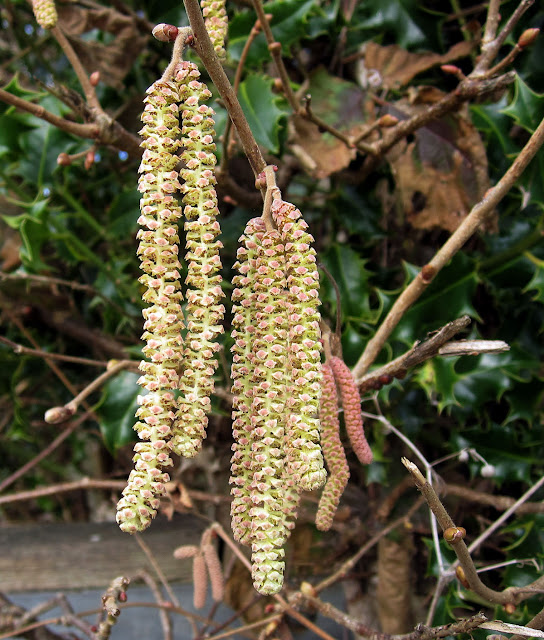 |
| Cudham churchyard with sheep, 25 February 2012. |
Another day out with the Orpington Field Club. This walk started and finished at Cudham. On our last visit there we went down into the valley to the west; this time we went eastwards, across the valley and through Newyears Wood.
The top photo is Cudham churchyard, in which those two sheep are grazing. This is a good way to manage grass length when the ground is as uneven as you see. All those small hummocks are old and overgrown ant nests.
On the edge of the recreation ground was an Alder, full of catkins that gave off clouds of yellow pollen at the touch of a finger.
 |
| Alder catkins, Alnus glutinosa, in Cudham recreation ground. 25 February 2012 |
And later we saw some Hazel catkins, just as ripe, on a trimmed-back shrub in a hedgerow.
 |
| Hazel catkins, Corylus avellana. 25 February 2012. |
One of the group commented at the start that I would not find much to photograph today. In fact there was plenty, though not so much as on some walks. We followed footpaths to start with, and then bridleways down into the valley. This sign is clearly for horse riders; both the paths ahead are bridleways, so this must be meant for people from a particular stable. We saw several horses, on roads and bridleways; it's a popular pastime in this area.
 |
| Horseshoe sign on a bridleway near Cudham. 25 February 2012. |
There were lots of fresh green leaf shoots to be seen. Honeysuckle, Cow Parsley, and Dog's Mercury were abundant.
 |
| Dog's Mercury, Mercurialis perennis, by the side of a bridleway near Cudham. 25 February 2012. |
We had a break at Strawberry Bank, a chalk bank managed by Bromley Council dedicated to the memory of a local naturalist, Gordon Dickenson. It's mown flat at the moment, but we could see signs of the rich plant life to come.
 |
| Some of the group resting on Strawberry Bank. 25 February 2012. |
There were occasional Primrose flowers, and I saw a solitary Wild Strawberry flower. We had a moss enthusiast in the group who showed me a few of those which grow on chalky soil, including this one:
 |
| Pointed Spear-moss, Calliergon cuspidatum. A chalk soil moss. 25 February 2012. |
The so-called common names of most mosses are not really common. They were made up in recent times, and are known only to bryologists. In many cases I think you have to have some experience to tell mosses apart, but this next one is fairly distinctive. It was growing on clay soul by the bridleway. There aren't many native species that grow in this tree-like fashion. Its Latin name means fox-tailed; our moss expert added to my education by explaining that the word alopecia originally meant fox-mange.
 |
| Fox-tail Feather-moss, Thamnobryum alopecurum. A dendroid moss. 25 February 2012. |
As we walked on through Newyears Wood, a group of small deer ran across a ride ahead of us. I just managed to get a shot of the last one with my iPhone; this clip is not very good, but it was this or nothing! One of them was leaping with all four legs at once, like a cutesy cartoon. Apparently nature can be cute too.
 |
| Roe deer crossing the path in Newyears Wood. 25 February 2012. |
Most of these photos were taken with my Ixus 100. Strawberry Bank and the deer were taken with my iPhone. I used that for the Strawberry Bank shot to take advantage of the high dynamic range feature, to capture the small branches and the clouds as well as the land. And for the deer, it was what I had in my hand.
Finally, a shot that probably interests only me. Most of the country gates have little stamped metal plaques like this, showing the makers' names. This one is fairly new.
 |
| Gate maker's sign at Strawberry Bank. 25 February 2012. |










In alopecurum, it's the -urum part that means tail. Alopeke just means fox-skin; alôpês means fox. In modern as well as ancient Greek.
ReplyDelete